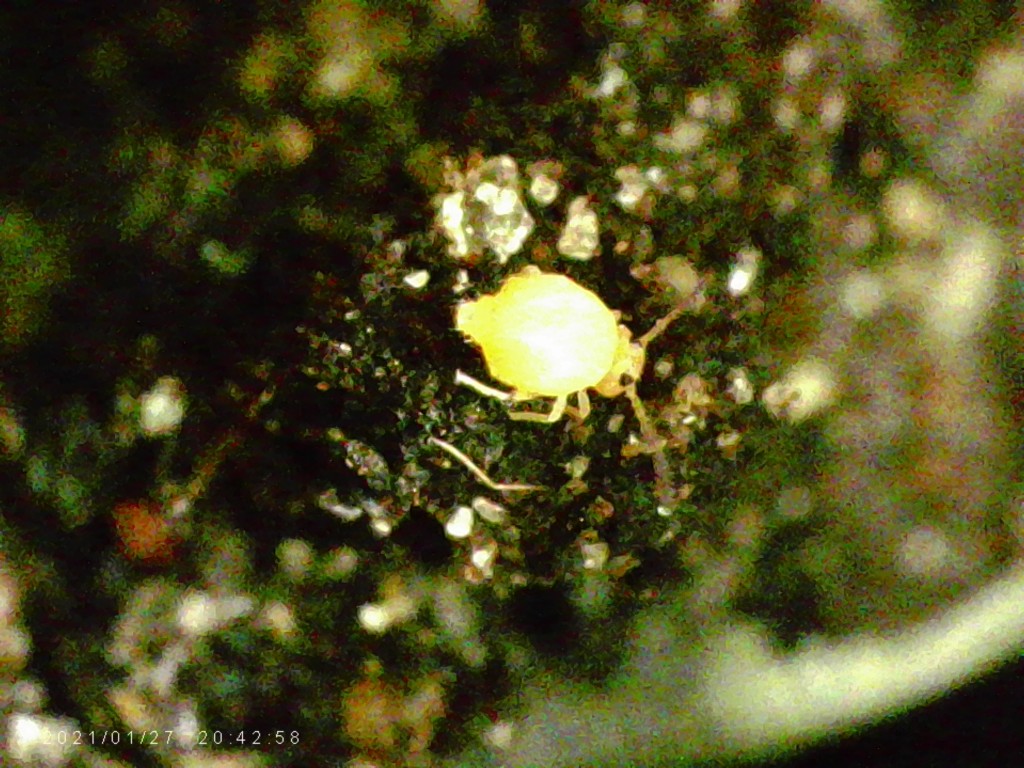Springtails (Collembola ) are anthropods within the class of hexapoda. Many specialists now classify them in a separate subclass called Entognatha due to the fact that their mouth parts are not external (like insects) but rather they are internal (or mostly so). They are named for most of the species ability to jump short distances by using their tails as a spring board. This special tail like structure, called a furcula, is forked and kept latched under its abdomen; when released it lets the tail fall to the ground and propels the springtail into the air like a spring board. This ability to jump often causes gardeners to mistake them for fleas, but springtails do not bite. One of the notable species commonly referred to as “snow fleas” begin appearing on the snow on warm sunny days in January and February. They can appear by the hundreds of thousands looking like jumping dirt on the snow. Springtail occur in soils abundantly around the world.
Identification
There are hundreds of species of springtails appearing to be either elongated (like the species in the Entomobyryidae and Onychiuridae families) or globular in shape (like the ones in the Sminthuridae family). They are very tiny and difficult to see without magnification ranging in size from 1mm to 6mm depending on the species. They are commonly cream, gray or dull purple in colour but some species are yellow, orange, metallic green, lavender, red or multi coloured. Springtails are wingless and have six legs on their thorax, segmented bodies, 2 antennae, a furcula (fork tail), and a collophore (a tube-like structure used for grooming). Most species have eyes but there are a few without.


Habitat
Springtails are attracted to moist areas high in organic matter. They can be found in soils, leaf litter, compost piles, organic mulches, rotting wood, green houses, lawns and on the surfaces of stagnant water or swimming pools. During hot dry weather they may invade homes in search of moisture.
Feeding Habits and Damage
The majority of springtails feed on decaying organic matter, mold, bacteria and other soil microbes. Some species like the clover springtail (Sminthurus viridis) aka lucerne flea, feed on crops, pastures and weeds; they are particularly fond of broadleaf plants. Some of the plants clover springtails feed on include: clover, soy, alfalfa, chard, tobacco, broad bean, vegetable and flower crops, canola, field peas, lupins, faba beans, ryegrass, wheat and barley, shepherd’s purse, chickweed, common sow thistle, wild radish, capeweed and other herbaceous plants.
The majority of springtails do not damage healthy plant material. Their presence in the soil is actually beneficial for nutrient recycling in addition they feed on harmful fungi, organisms with disease and clean up dead plants, dead worms and flies. For those species that do feed on healthy plant material damage is often minor; appearing as rounded pits on roots and small holes in leaves caused from young nymphs (giving the leaves a speckled appearance), or ‘window paning’ of leaves caused by older nymphs. Plants are most vulnerable when they are seedlings; heavy feeding may cause them to wilt and die.
Life Cycle
Collembola eggs overwinter in the soil. In the late winter or early spring (depending on the species) when conditions are right the eggs begin hatching. The nymphs resemble the adults and go through several moults before becoming sexual adults. The period from egg to the adult stage can be as little as four to six weeks. The adults mate via the male depositing sperm packs (spermatophore) in the soil after a brief courtship and the females pick up those packs (if they are interested) and use them to fertilize their eggs. The eggs are laid and if conditions are right they quickly hatch. There can be several generations per year.
Control and Management
Most of the springtails are not harmful to the garden and rarely need chemical intervention. If springtails are a problem in the vegetable garden or ornamental garden ensure there is good drainage and reduce irrigation, allowing the soil to dry out between watering. Reducing organic amendments like mulches and compost will also help. Spiders and beetles are natural predators as are snout mite and spiny snout mites. There are chemicals available to control springtails for regions allowed them.
If springtail have invaded your home seek out high moisture areas such as leaky plumbing, leaky gutters, cracks in foundations, etc. and correct them. A dehumidifier should also help. Caulk windows and doors if needed and repair screens. You may want to call a pest control service if the numbers are high.
Photo credits: all photos by the author.
References and reading resources:
Whitney Cranshaw 2004. Garden Insects of North America. pg. 504-505, Princeton, New Jersey, Princeton University Press
All about Collembola/springtails- Symphypleona – A Chaos of Delight
(Italiano) Sminthurus viridis: Sistematica, Habitat, Ciclo biologico, Lotta, … (antropocene.it)
Sminthurus viridis – Wikipedia
Species of UK: Week 14: Springtails (Collembola)
ENY-228/IG124: Springtails (ufl.edu)
(Italiano) Sminthurus viridis: Sistematica, Habitat, Ciclo biologico, Lotta, … (antropocene.it)
175_Plantain Pests – Springtails.pdf (nzforagesystems.co.nz)
Springtails – what do springtails do and how do you get rid of them? (tamu.edu)
Springtails Management Guidelines–UC IPM (ucanr.edu)
Lucerne flea – Cesar Australia
How To Catch Springtails in The Wild: An Effective Guide! – VivariumTips
(Italiano) Sminthurus viridis: Sistematica, Habitat, Ciclo biologico, Lotta, … (antropocene.it)
Northwestern Ontario Insect Species – Order Collembola (borealforest.org)
All rights reserved

